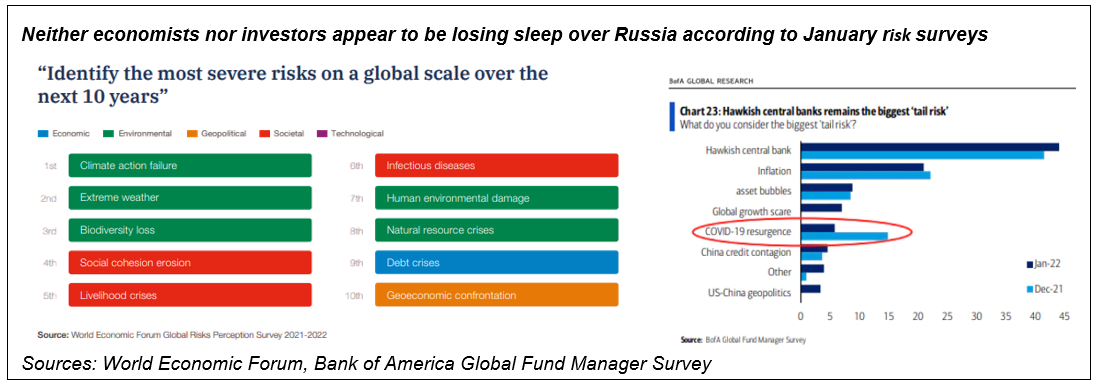The World Economic Forum's latest Global Risks Report 2022 placed geoeconomic confrontation as the tenth most severe risk over the next decade and twelfth in its list of risks that have worsened during the pandemic. With tensions running high between Russia and Ukraine as well as North Korea recommencing its missile programme, one might have expected it to feature higher in this January's rankings, which were dominated by environmental and societal threats.
Bank of America's global fund manager survey at the start of the year showed that investors are similarly relaxed about Russia. It didn't register in its list of the biggest tail risks, with hawkish central banks by far the largest worry, and US-China relations appeared as the only geopolitical concern amongst the top eight.
But with the situation escalating and Russian soldiers at the Ukrainian border, should investors be worried and what impact might this have on SKAGEN's funds?

Risk in a SKAGEN context
As stock-pickers with a focus on value, SKAGEN's specialism is companies rather than international relations. This means that we continually assess the return potential of our portfolio companies against the risks they face, including from geopolitics, as well as alternative investment opportunities elsewhere.
Threats of crises tend to spark a knee-jerk response, which almost always is recuperated over time by patient investors. One of the biggest cliches in the market is that stocks take an escalator up, and an elevator down. Taking sensible risks at the right time is key to long-term investment success. Some of SKAGEN's best investments over the years have been made when market sentiment is at rock bottom. As Warren Buffet famously said: “Be fearful when others are greedy and greedy when others are fearful”.
The investment team is closely monitoring events in Ukraine to find investment opportunities that may arise from a market dislocation. To put the current situation in context, the MSCI Russia Index is down 4% this year in EUR (the MSCI Emerging Market Index is flat, in comparison)[1]. Undoubtedly this is painful for investors but far from terminal, particularly following Russian gains of 28% in 2021 versus 5% for the index.
Among our portfolios, none of SKAGEN Global, SKAGEN m2 or SKAGEN Focus have direct exposure to Russia. SKAGEN Vekst has 4.5% of its portfolio invested there but this hasn't prevented the fund comfortably outperforming its benchmark index so far this year. SKAGEN Kon-Tiki unsurprisingly has the largest exposure to Russian companies which make up 8.7% of the portfolio, compared to 3.3% of the MSCI Emerging Market Index (that the fund is beating so far this year).
Opportunities in Russia and abroad
While Russian stocks could fall further if war breaks out or sanctions are imposed, their sell-off since October last year means that current valuations could offer investors protection. The Russian market currently trades at a discount to historic averages, including during the annexation of Crimea and oil price crash of 2014 – suggesting risks may now be more on the upside. Just as Kon-Tiki's contrarian investments in China during last year's sell-off are already starting to pay off, Russia could provide similar opportunities in 2022.
There is a chance of contagion into global markets depending on the scale of escalation, as well as uncertainty surrounding commodity and energy prices which impacts companies globally. SKAGEN's portfolio managers are considering both the opportunities and threats that lie within these second order effects as they review each portfolio. The benefit of having broad mandates is the leeway available to identify mispricing on a global scale and position accordingly. Volatility today creates opportunities for better returns tomorrow, for those who have the patience to ride it out.
[1] Source: MSCI, as of 15 February 2022.




